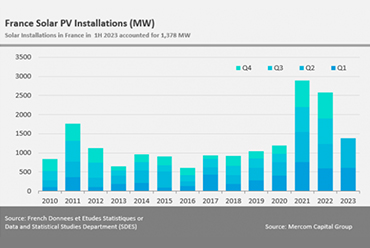
In the first half of 2023, France's solar installed capacity was 1378MW, compared to 1233MW in the same period last year. From January to June, France's solar power generation reached 11.2 TWh, a year-on-year increase of 18%. Solar power generation accounts for 4.7% of France's electricity consumption, a year-on-year increase of 0.9%. As of June 30, 2023, the installed solar capacity in France is 18GW, of which 17.3GW is domestically produced. In the first half of 2023, the Auvergne Rh ô ne Alpes, Occitanie, Nouvelle Aquitaine, Provence Alpes C ô ted 'Azur and PaysdelaLoire regions played an important role in expanding solar power generation. These regions together account for 67% of the newly added grid connected capacity in China. Although it only accounts for 0.2% of the total number of new grid connected equipment, between January and June, approximately 39% of the power generation came from new devices above 250kW. Equipment with smaller power, especially those below 9kW, account for 94% of new grid connected equipment and 24% of newly generated electricity. The capacity of ongoing projects has experienced a significant increase, increasing by 19% since the beginning of the year to 20.1GW. Among these projects, 4.49GW have signed a grid connection agreement. In France, 41.6% of photovoltaic installation comes from self use power generation projects (accounting for 78.5% of installed capacity), an increase of 1.2% compared to the previous quarter. The installed capacity of self use projects is 297GWh, accounting for 3.9% of the total photovoltaic power generation in this quarter. In August, the French Ministry of Ecology and Solidarity and Transformation announced the list of winning bidders for the fifth round of commercial and industrial rooftop solar projects, which have a power generation capacity of over 500kW and a total power generation capacity of 378MW. The average quotation of 60 winning bidders is 0.1019 euros (approximately 0.1102 US dollars)/kWh. The European Parliament and Council have temporarily agreed to raise the EU's binding renewable energy target from 32% to at least 42.5% by 2030. This means that the proportion of renewable energy in the EU will double. UISOLAR is also committed to making a cleaner world by providing solar mounting structures all over the world. We have developed many different solar mounting solutions for specific project conditions. The general categories are solar ground mounting, solar roof mounting, solar carport mounting, etc. Customized is acceptable, even under severe conditions, and we hope to contribute to environmental protection by spreading our products around the world.
Read More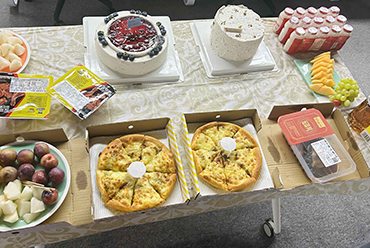
In the afternoon of Aug. 22nd, UISOLAR team Celebrate the Team Birthday all together. At the same time, today is also the Chinese Valentine’s Day. Since from 2010 UISOLAR was set up, most of us experience the fall in love, get married, give birth to children in UISOLAR. We are all growing , so do UISOLAR, since from a small mounting supplier to now a well known Mounting Specialist. At the beginning, UISOLAR can only offer the Pitched roof mounting ( including Rail + L feet Solution, Rail + Tile roof hooks solution + Clip lock clamping solution), Flat roof mounting ( Ballast mounting + flat tin roof mounting). Nowadays, besides above products( most of them have been improved), we also have different types of Ground Mounting Solutions (Both Aluminum and Steel), Carport solutions( both Steel and Aluminum ), Solar Farms, and Mini Rail Roof Mounting ect. And for the tile hooks and clamping hook, we have more and more products to meet different needs. At the same time, we also accept the OEM service for our Clients.
Read More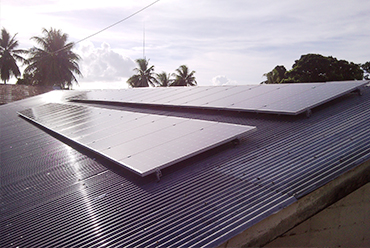
The recent hail storms that occurred in northern Italy have drawn attention to the damage that these sudden and violent atmospheric events can cause to photovoltaic systems. Several system owners have posted photos of damaged plants on social networks, clearly demonstrating the violence of the hailstorms and, above all, the size of the hailstones, which in some cases even reached 20 cm in diameter. But how big do these grains have to be to damage a photovoltaic system? What can be considered a critical threshold beyond which the damage becomes significant? pv magazine Italy tried to answer these questions by dusting off a 2019 report by the Vrije Universiteit Amsterdam (VUA) which had investigated the insurance damage data of a historic hailstorm that occurred in June 2016 in the Netherlands. According to the conclusions of the Dutch researchers, damage to solar panels occurs primarily with hailstones with a size exceeding at least 3 cm. “Larger hailstones (more than 4 cm) cause more damage on average than smaller hailstones, but they also show greater variety in the amount of damage to solar panels,” they explained in the paper “The vulnerability of solar panels to hail.” Starting at 3 cm, both invisible and visible damage can occur, but starting at 4 cm, the percentage of visible damage increases significantly. Popular content The smallest cracks (microcracks) do not form in the front glass layer but in the silicon, resulting in no reduction of the initial yield. After a few months, however, the damaged areas may begin to show a rapid drop in power, and after about a year the micro-cracks also become visible on the outside of the panel. All damage then reduces the lifespan of a solar panel. The orientation of the roof relative to the direction of the hail can greatly affect the damage caused by hail to solar panels, the researchers explained, noting that this factor could be even more decisive than the size of the hailstones. Then there is some empirical evidence – on the other hand, not too significant – that even the angle at which the solar panels are installed can influence the damage to the solar panels. A greater inclination, according to the conclusions of the scientists, would help to moderate the damage. The study also shows that the frequency of hailstorms is increasing in Europe and the Netherlands, as is the damage caused by hailstorms. This indicates that exposed items, such as solar panels, could become more vulnerable in the future. “Hail risk and the vulnerability of solar panels to hail should be included in risk models and climate adaptation strategies,” the Dutch researchers concluded.
Read More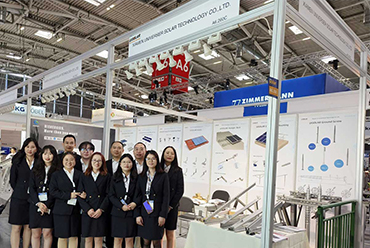
Intersolar Europe is the world's leading exhibition for the solar industry. Under the motto “Connecting solar business,”manufacturers, suppliers, distributors, service providers and project planners and developers from around the world meet in Munich every year to discuss the latest developments and trends, explore innovations firsthand and meet potential new customers. Intersolar Europe takes place as part of The smarter E Europe parallel to the three energy exhibitions ees Europe, Power2Drive Europe and EM-Power Europe at Messe München from June 14–16, 2023. There are many manufacturers, suppliers, distributors, service providers and project planners and developers from around the world attend it. UISOLAR is one of manufacturers inside Intersolar. Our booth NO.A6.260C. Welcome to our booth!
Read More
To power the planet, global solar experts are strongly committed to achieving continued growth in PV manufacturing and deployment. They believe that underestimating PV growth projections while waiting for consensus on other energy paths or last-minute technological miracles is “no longer an option.” The consensus was reached at the third annual Terrawatt Workshop, held earlier this year. Several groups around the world are making increasingly high projections for the demand for large-scale PV to drive electrification and greenhouse gas emissions reductions. With the growing acceptance of PV technology, experts suggest that by 2050, approximately 75 TW or more of PV power will be needed globally to meet decarbonization goals. Led by representatives from the National Renewable Energy Laboratory (NREL), the Fraunhofer Institute for Solar Energy Research in Germany, and the National Institute of Advanced Industrial Science and Technology in Japan, the symposium brought together leaders from research institutions, academia, and industry from around the world in the fields of PV, grid integration, analysis, and energy storage. The 2018 conference further raised the goal to reach about 10 TW by 2030 and three times that amount by 2050. Participants at that workshop also predicted that global PV capacity would reach 1 TW within the next five years, a successful prediction, with that threshold being breached last year. Nancy Haegel, director of NREL's National Photovoltaic Center, said, "We've made great progress, but to get there, we need to keep working and keep accelerating." Haegel is the lead author of a new article in the journal Science, "Multi-Terawatt Photovoltaics: Waiting Is Not an Option. The co-authors are from 41 institutions in 15 countries." NREL Director Martin Keller said, "Time is of the essence, so we must set goals that are high-impact, ambitious, and achievable, and in the field of photovoltaic solar energy, we have made great progress and will achieve even more as we continue to innovate and act with urgency." Incident solar radiation could easily provide more than enough energy to meet the Earth's energy needs, but only a small fraction of it is available for use. Global photovoltaic power generation has increased dramatically from negligible in 2010 to 4-5% in 2022. The workshop report notes that "the window for large-scale action to reduce greenhouse gas emissions while meeting future global energy needs is closing with each passing day." Photovoltaics is one of the very few options that can be used immediately to replace fossil fuels." A major risk for the next decade is making the wrong assumptions or mistakes in modeling the growth needed for the PV industry, and then realizing too late that our failures lie in low-level expectations." Workshop participants also expressed the need to redesign solar technologies for eco-design and recycling. Installations to date have been relatively low compared to demand over the next 20 year...
Read More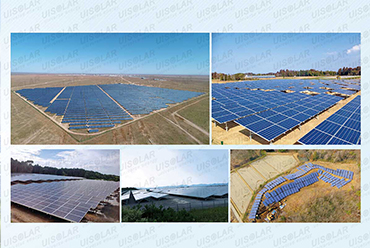
The ASEAN Centre for Energy (ACE) and the International Renewable Energy Agency (IRENA) organised a virtual webinar promoting dialogue among Governments, development partners and regional and multilateral institutions on the regional and national perspectives for accelerating energy transformation in the ASEAN region on 21st,March 2023. Experts and scholars from China, the Philippines, Indonesia, Pakistan, and Bangladesh spoke freely about "the development potential and challenges of solar energy in Southeast Asia and South Asia". "We have a clear stance on renewable energy. The goal is to increase its share in the energy mix from the current 21% to 43% by 2030, and solar energy will play a key role in it." Former Philippine Energy Planning Agency (now Alberto Dalusung III, director of the Department of Energy and current energy transition consultant at the Center for Climate and Sustainable Cities, pointed out. Indonesia's solar radiation intensity is also very high, with an average daily radiation of about 4.8 kWh per square-meter. Beyrra Triasdian, manager of the renewable energy project department at TrendAisa, revealed that hydroelectric, solar energy, and geothermal are the three most potential renewable energy sources in Indonesia, but overall, the country's renewable energy potential far exceeds the current deployment quantity. Bangladesh plans to double the share of solar power to 20 percent by 2040, and rooftop solar power is becoming increasingly popular in the country, with many industrial parks keen to develop the project. The country plans to build 100 special economic zones by 2035, half of which will vigorously apply rooftop solar power. Pakistan's average daily solar radiation of 5.3 kilowatt hours per square meter, the country plans to install solar power systems on all government buildings in the country, and from April the federal government building will be the first to rely entirely on solar energy supply. Mirza Hamid Hassan, former secretary of Pakistan's Ministry of hydroelectric and now a senior research consultant at the Institute for Policy Studies, said Pakistan aims to increase the share of renewable energy generation to 50 percent by 2030 from the current 34 percent. Opportunities and Challenges Shahriar Ahmed Chowdhury, director of the Energy Research Center of the United National University of Bangladesh and chairman of the International Conference on Renewable Energy Technology Development Organization, noted that the area of land suitable for developing solar power plants is limited, and land ownership issues make land acquisition more difficult. In addition, the electricity infrastructure is not developed enough, the power grid has not yet achieved good interconnection, and the development of smart grid is also very slow. Indonesia is also facing challenges in infrastructure and financing. Deepen cooperation for common development According to the data from China's General Administration of Customs, the import a...
Read More online service
online service +86 (0592)5663849
+86 (0592)5663849 sales@uisolar.com
sales@uisolar.com solar-mount.au
solar-mount.au